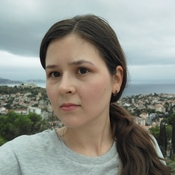Theoretical seminar | 30 March 2022
Online

The strong force is one of the four fundamental forces of nature. It manifests in binding quarks into hadrons. Most of the ordinary matter is composed of two hadrons - neutron and proton, that further compose atomic nuclei. However, at higher energies the variety of observed states is very vast: from all kind of two- and three-quark combinations out of six possible quark types (mesons and baryons) to the exotic states (glueballs, tetraquarks, pentaquarks).
Theoretically the strong force is described by a quantum field theory named quantum chromodynamics (QCD) that is a part of the Standard Model. There is an important issue with QCD: it is asymptoticaly free, i.e. the interaction strength between particles decreases at high energies. Due to that a new state of hadronic matter, quark-gluon plasma (QGP), is formed at high temperatures and/or densities. On the other hand, at lower energies we observe confined states, hence a confinement-deconfinement phase transition happens at some point. A primary question of QCD is to clarify the phase diagram of matter as a function of temperature, baryon chemical potential, and other external parameters. It is essential for the understanding of laboratory experiments involving relativistic heavy-ion collisions such as carried out at LHC, RHIC and in future at FAIR.
As it happens, the process of deconfinement cannot be described straightforwardly in QCD. One of the reasons is that perturbative methods of calculation become inapplicable at energies lower than ~ 1 GeV, and non-perturbative methods must be used.
There is a new non-perturbative approach based on AdS/CFT (anti-de Sitter/Conformal Field Theory) duality that could be applied to QCD in strongly interacting regime called holographic QCD. First, we will browse the successes of bottom-up holographic QCD in describing meson and glueball spectra, and then turn to the confinement-deconfinement transition which in holography corresponds to the Hawking-Page transition between spacetimes with different geometries. We will find quantitative expressions for the critical temperature of phase transition and compare them to the values obtained with other methods.
S. S. Afonin and A. D. Katanaeva, Glueballs and deconfinement temperature in AdS/QCD, Physical Review D 98, 114027 (2018) [arXiv:1809.07730[hep-ph]]
Last news
-
-
Quantum Liquid “Cooling” Without “Evaporation” Described at ITMO
-
ITMO Scientists Create Perovskite Memristor To Withstand 1,500+ Rewrite Cycles
-
Butterfly Effect: ITMO Researchers Create Colorful Perovskite Films for Optoelectronics
-
Scientific Show, Lectures, and Lab Tours: Recap of Physics Day 2025 at ITMO
